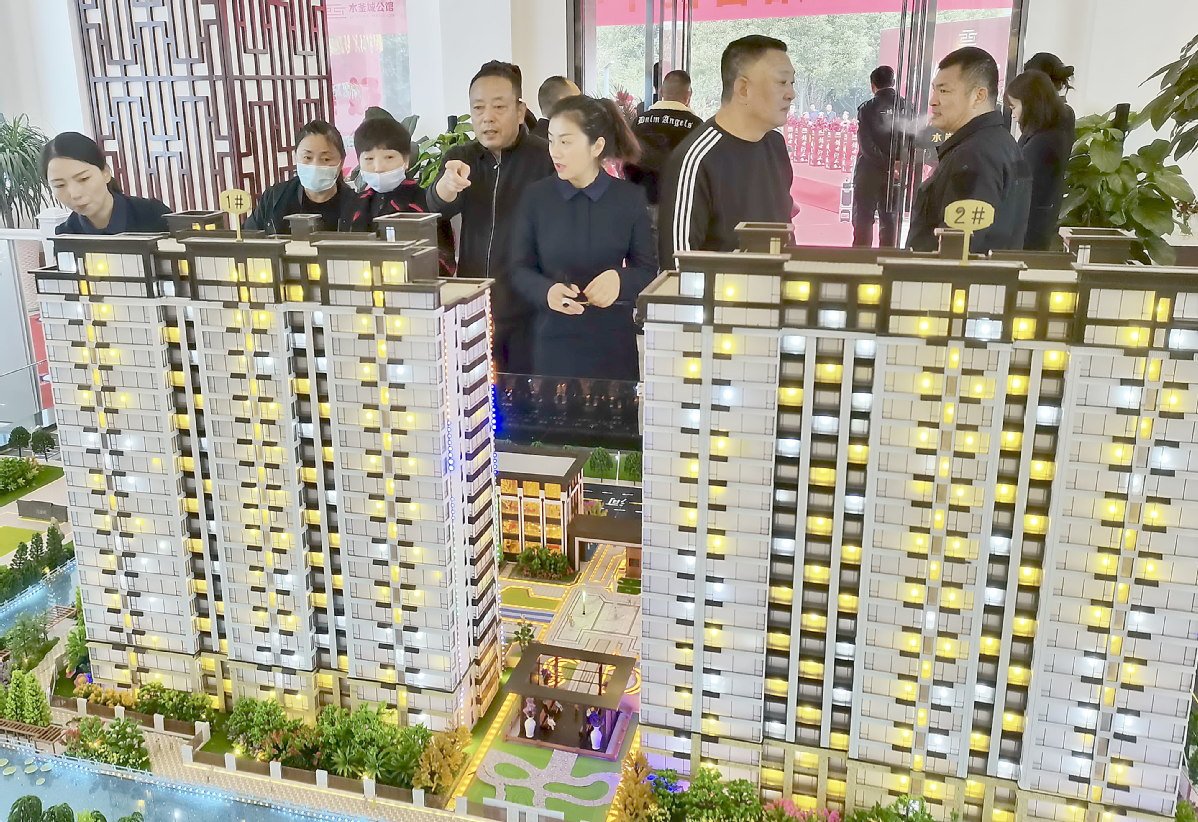Property recovery in need of more policy support


With the economy facing downward pressure burdened by slowing external demand and fluctuating domestic demand, stabilizing real estate investment as soon as possible is key to keeping economic activity on a steady track and achieving various development targets this year. However, judging from the January-May data, the property sector is still struggling to get back on track.
Hitting bottom
Since 2021, the growth rate of the balance of real estate development loans has hit record lows. The successive defaults of some real estate companies have damaged investor confidence, and domestic and overseas bond issuances of real estate companies are confronted with various woes.
Taking cognizance of the real estate downturn, the People's Bank of China, the central bank, took the lead in making a proactive call in September. Then in January this year, the Ministry of Housing and Urban-Rural Development proposed to fully release residential demand for housing, and many second- and third-tier cities gradually relaxed control policies. In February, the decline in the growth rate of housing sales area began to ease.
However, due to COVID-19 resurgences in some regions in March, property sales growth rates dropped sharply again in March, hitting the nadir of the downturn later than expected. On April 29, the Political Bureau of the Central Committee of the Communist Party of China proposed that local governments roll out policies based on local realities to support rigid demand for housing or for housing upgrades. With expectations that the regulatory policy would be further relaxed in the next stage and the housing financial environment further improved, and considering the impact of the COVID-19 pandemic, we think sales may hit rock bottom in the second quarter.
Judging from the leading indicator of the weighted average interest rate of personal housing loans, the interest rate of personal housing mortgage loans entered a downward phase in the first quarter. This year, to fully release housing demand and maintain smooth market operations, the PBOC lowered the over-five-year LPR (loan prime rate) quotation, followed by many provinces and cities also seeing their housing loan interest rates lowered. At the end of the first quarter, the weighted average interest rate of personal home loans was 5.49 percent, a decrease of 14 basis points compared to the end of last year.
Therefore, the downward inflection point of mortgage interest rates in this round of a downtrending real estate cycle began to appear, which also seems to indicate a bottoming out at the end of the second quarter. However, it should be noted that due to limited rate cuts, relatively moderate policies compared to those of 2014-15, and diminished sentiment among homebuyers, we expect a relatively weak rebound after the market hits bottom.
Since 2021, the financing environment for housing enterprises has been substantially tightened. In terms of indirect financing, the growth rate of real estate development loans continued to decline. As of the end of the first quarter, the balance of real estate development loans fell by 0.4 percent year-on-year, 1.3 percentage points lower than that of the end of the previous year, nearly 25 percentage points lower than the third quarter of 2018.
The same goes for direct financing. As of April, the cumulative issuance of credit bonds in the Chinese mainland by real estate enterprises reached 182 billion yuan ($27 billion), down 34 percent year-on-year. The balance of real estate firms' bond financing in US dollars was $194.3 billion. Despite an increase of 18.3 percent year-on-year, the growth rate was 8.5 percentage points lower than that at the end of last year. The severe financing environment has restricted the recovery of real estate development investment growth to a certain extent.
Until recently, the central bank has worked to maintain a stable and orderly issuance of development loans, urging commercial lenders and financial asset management companies to efficiently handle merger and acquisition work in risk disposals of some key housing enterprises, carry out M&A loan business in a stable and orderly manner and increase support for M&A bond financing. Some top-level meetings also emphasized optimizing the supervision of pre-sale funds for commercial housing.
With the help of proactive policies, the pressure points on the financing of housing enterprises in the next stage are expected to be gradually tackled, financing channels broadened and the financing situation of housing enterprises gradually improved. Also, due to supportive policies in the real estate market since the latter half of last year, there have been signs of recovery reflected by changes in land premium rates, which usually lead real estate investment by about three quarters. Therefore, we estimate that real estate development will stabilize in the third quarter.
From the perspective of liquidity, the M2 year-on-year growth rate continued to pick up. This reflects a sufficiency of funds in the entire market and has a greater impact on the real estate market. In December, the year-on-year growth of M2 returned to a level of over 9 percent, ending the downward trend for 10 consecutive months. And in May, the M2 growth rate reached 11.1 percent, an increase of 0.6 percentage point from the previous month, which also means that real estate development investment is more likely to stabilize in the third quarter of this year.
In the short term, considering the great downward pressure on the economy this year, real estate, as a pillar industry, urgently needs to play its role as a "stabilizer". The current real estate market is still in the process of bottoming out. Although support from housing financing policies has been increased and regulatory policies in many cities have been relaxed, the unleashing of demand is still slow. Given the impact of COVID-19 resurgences since March, the effect of the previous policy has been relatively compromised.
Finding a way out
At present and in the next stage, it is necessary to further introduce strong policy measures from the perspectives of supply and demand, aiming at the differentiated characteristics of the real estate market in various places, to focus on promoting the unleashing of housing demand, improving the financing environment for property plays, accelerating the pace of investment recovery, and as a result promoting healthy and steady development of the real estate market.
From the perspective of demand, the nation should first further provide stable residential housing credit support, moderately reduce mortgage interest rates, and meet the demand for improved housing. The current national personal mortgage interest rate level is similar to the level in June 2020, but is still about 90 basis points higher than the interest rate level of 4.52 percent in the second quarter of 2016. It is recommended to further reduce mortgage interest rates nationwide and moderately reduce the provident fund loan interest rate.
Second, the nation should increase financial support to help homebuyers afford better living spaces, and reduce non-market-oriented restrictive housing purchase policies. Local governments can also encourage lenders to grant loans for those repurchasing ordinary commercial housing to improve their housing conditions, provided that they meet specific conditions, such as those who have fully paid off their first home loan.
Third, different policies for different cities should be furthered, and more cities should move to lower mortgage down payment ratios. For those with high housing inventories and strong dependence on land financing, the government can put forward measures such as canceling purchase restrictions and lowering down payment ratios to step up demand and handle inventory depletion.
From the perspective of financing, commercial banks should speed up the approval and issuance of development loans. In the first quarter, the growth rate of housing development loan balances was-0.4 percent year-on-year-the first negative growth on record. Financial support from lenders for housing enterprises is far from adequate. Lenders should not stop lending or withdraw loans. They should keep their expectations stable and meet reasonable capital needs of housing enterprises. Reasonable assessment of the credit status and repayment ability of real estate enterprises should be well undertaken.
Second, it is key to create a loose financing environment and increase direct financial support for high-quality housing enterprises. Affected by the decline in sales, the poor credit status of housing companies and weak expectations, and the current bond issuance situation of most private housing companies, have not improved. It would be wise to moderately increase direct financial support for high-quality private real estate enterprises to alleviate their financial risks.
Third, appropriate adjustments should be made to those stringent provisions in current land auction rules to increase land supply and reactivate the land market. It is advisable to appropriately reduce the amount of deposit payments, extend payment periods for transfer fees to help real estate companies reduce land acquisition costs and increase enthusiasm for participating in land auctions.
As there is always a time lag in the transmission of policies to investment, appropriate policy adjustments should be made sooner rather than later.
The writers are Lian Ping, chief economist and head of the Zhixin Investment Research Institute, and Li Xiaoqing, a researcher with the institute.
The views don't necessarily reflect those of China Daily.




































